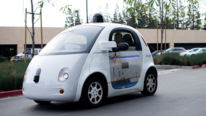Google’s self-driving car project has been spun off into a separate company, in a move that suggests robot-controlled vehicles may be whizzing around public roads soon.
The new entity, called Waymo, says its aim is to
“make it safe and easy for people and things to move around”
.in driverless cars.
Rather than manufacturing self-driving cars, the company is focused on developing the technology that enables them to work – something which could be of interest to Apple and traditional carmakers who are all scrambling to be the first to launch a production-ready model.
At a news conference, Waymo’s chief executive John Krafcik said:
“We can see our technology being useful in personal vehicles, ridesharing, logistics or solving last-mile problems for public transport.”
Google’s high-profile programme began seven years ago in a secretive lab – and since then its driverless cars have covered more than 2.3 million robot-controlled miles, usually with an engineer on hand in case something went wrong.
But a crucial milestone for the tech giant came in October 2015, when the first fully autonomous ride was given to a blind man in Texas with no one else in the car.
Under Google’s parent company Alphabet, which oversees far-flung projects detached from its core business of online search and advertising, Waymo’s creation could help monetise years of research.
Unlike other automakers, Waymo’s goal is to create an autonomous vehicle which requires absolutely no human intervention – and these days, testing is focused on the most challenging scenarios that old-fashioned cars can face on the road.
“We believe that this technology can begin to reshape some of the 10 trillion miles that motor vehicles travel around the world every year – with safer, more efficient and more accessible forms of transport,”
Mr Krafcik, a former executive for Hyundai, told reporters.
The name Waymo stands for “a new way forward in mobility”. Via:sky.com









